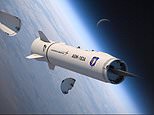Maritime ($75 billion)
Expanded maritime force to provide greater capability for anti-submarine warfare, sealift, border security, maritime patrol, aerial warfare, area denial and undersea warfare.
Between $168 and $183 billion for the acquisition or upgrade of Navy and Army maritime vessels out to the 2050s. Between $5 to $7 billion in undersea surveillance systems.
Between $400 to $500 million in long range maritime strike missiles.
Air ($65 billion)
Expanded air combat and mobility and new long range weapons and remotely piloted and autonomous systems will be introduced.
Between $10 and $17 billion investment in fighter aircraft. Between $700 million to $1 billion for Operational Radar Network expansion.
Between $3.4 billion and $5.2 billion to improve air launched strike capability.
Between $6.2 and $9.3 billion in research and development in high speed long range strike, including hypersonic research to inform future investments
Between $7.4 and $11 billion for remotely-piloted and autonomous combat aircraft, including air teaming vehicles.
Land ($55 billion)
Investment to ensure land forces have more combat power, are better connected, protected and integrated with each other and with our partners. Between $7.4 and $11.1 billion on future autonomous vehicles.
Between $7.7 and $11.5 billion for long range rocket fires and artillery systems including two regiments of self-propelled howitzers.
Between $1.4 and $2.1 billion for Army watercraft including up to 12 riverine patrol craft and several amphibious vessels of up to 2,000 tonnes to enhance ADF amphibious lift capacity.
Defence Enterprise ($50 billion)
Investment key infrastructure, ICT, innovation and Science and Technology programs critical to the generation of Defence capabilities.
Between $6.8 and $10.2 billion in undersea warfare facilities and infrastructure.
Between $4.3 and $6.5 billion to enhance Air Force’s operational effectiveness and capacity in the Northern Territory.
Between $900 million and $1.3 billion to upgrade key ports and infrastructure to support Australia’s larger fleet of amphibious vessels.
Between $20.3 and $30 billion to increase the supply of munitions and between $1 and $1.5 billion to explore expanding industry capacity for domestic guided weapons and explosive ordnance production capability.
Information and cyber ($15 billion)
Bolster offensive and defensive cyber capabilities, enhance electronic warfare and command and control systems and improve intelligence, surveillance and reconnaissance systems.
Space ($7 billion)
Investment to improve resilience and self-reliance of Defence’s space capabilities, including to assure access to capabilities, enable situational awareness and deliver real-time communications and position, navigation and timing.
Between $4.6 and $6.9 billion in upgrades and future satellite communications systems, including communications satellites and ground control stations under sovereign Australian control.
Between $1.3 and $2 billion to build our Space Situational Awareness capabilities.
